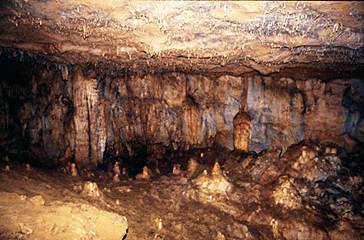|
Although the Jolja' texts are painted on a dry section of the wall, there is a wet area adjacent to them at the very end of the main passageway. The walls of this area are coated in flowstone formations, there are numerous stalactites hanging from its ceiling, and its floor is covered with stalagmites. There are also two large columns where stalactites and stalagmites have joined together. Behind the left column are a number of dripwater formations that have been sawn off from their original locations and placed here. On the wall behind the columns is an inscription encrusted with calcite deposit. Between the two columns is a small alcove with a pool of water. Such spaces replicate the mythological cave where corn was first found. The sacred nature of these formations explains why the Maya choose this particular space to conduct their rituals. In addition to these dripwater features, the location of Jolja' at the headwaters of a river contributed to its revered and pure nature. This is reflected in the Day of the Cross ceremonies that are performed at Jolja' Cave on May 3. Although this is a Catholic festival, the Day of the Cross ceremonies conducted in the Maya region frequently have aspects of pre-Columbian rain rituals incorporated in them because May 3 occurs at the start of the rainy season. In their 1965 publication of contemporary Ch'ol texts, Arabelle Whittaker and Viola Warkentin noted that the Day of the Cross rituals involved the setting up of a cross that will assure that "the water starts flowing again from its source". At the end of the dry season, the water stops flowing from the center cave of Jolja', but it begins to flow again with the onset of the rains.
|

|
![]()